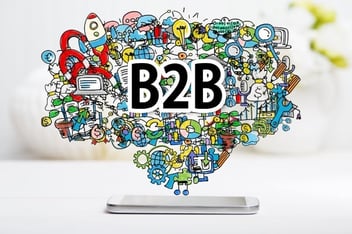Effective lead generation happens best when both marketing and sales talk to each other, share the same database and have aligned goals. If your B2B lead generation is stalling, check your departments are not only working together but supporting each other too.
This parallels your marketing and sales departments; both of which often aren't closely aligned enough to provide a successful breeding ground for effective B2B lead generation.
Marketing is there to create content they think will be successful and sales are off trying to sell. Without an aligned strategy, marketing doesn't help sales and sales don't sell!
But if there is one consistency it is the role of top-level management to initiate change and make them both not only play nicely but also partake in mutually beneficial activities.
There are three clear indicators that this might not yet be happening in your company:
Blame-game
A side-effect of misalignment is getting caught up in a merry-go-round blame game where poor results and bad practices are a precursor to finger-pointing and blame-tossing. A common side-effect of what can happen when departments don't collaborate on projects is a standard part of company culture. It causes frustrations, increased costs from higher staff turnover rates, increased cost of staff training and poor continuity; in short, the company makes less and ends up spending more.
Not sharing information
Marketing departments often use key metrics that can be highly relevant for their sales team. Unfortunately, the sales team are often not trained on how to use this information, meaning that valuable content isn't being used by the sales team. When it is, it isn't used in the way it was designed to be. It's like the marketing department creating multiple levels of content for leads to access throughout their sales journey and sales person unaware that their company actually has a sales funnel.
Fire-fighting
Let's face it, sales and marketing don't lend themselves well to the just-in-time method of production. A salesperson will phone up marketing to ask for content their customer needs. It isn't there and this results in a round of blame or the sales team decide to create this content themselves, taking them away from their responsibility of selling and further distancing them from marketing.
Why is There a Problem With Aligning Sales and Marketing?

For a start, the cultures of selling and marketing are very different. Marketing looks at understanding the value aspect of the product, whereas sales meet the needs of the buyer.
Film director Martin Scorsese understood this in his biopic The Wolf of Wall Street. Jordan Belfort hands his friend a pen and says "Sell me this pen". His friend takes the pen and says, 'OK, now right this down..." leaving Belfort to retort, "I don't have a pen!"
Sales have the power to make changes and directly influence customer decisions with interaction whereas the marketing team often relies on making marketing all about the product.
In reality, people will always buy what they perceive to be of value to them.
And when marketing departments and sales departments mutually confer, then marketing begins to create content that reflects the salesperson's need to add value for the buyer.
Start Aligning Sales and Marketing
One of the obstacles to alignment is that your teams just don't know why they should so. Alignment boils down to agreeing on goals, processes and metrics that are the most meaningful to the company and working backwards.
Lead from the top
Like King Lear famously said "Nothing comes from nothing", so if your marketing department isn't mixing it with your sales department then you need to start bashing heads, namely your marketing director and your sales director.
Highlight the benefits
And if you don't? Then marketing and sales will naturally refer to the type and result in the same problem you started with. To avoid this you need to emphasise what the mutual benefits of collaboration are. This means highlighting these two departmental character traits:
Data from sales is inherently valuable - Marketing uses information gathered on prospects from sales because they are essential for developing lead generation strategies.
Salespeople don't like extra work - When salespeople are required to input additional information on their clients, prospects and visits it can be viewed as intrusive or time-consuming red tape.
Aligning goals
When teams and departments are tasked with goals, it is natural they will start on the objectives that matter most to them. A good start then is to develop and emphasise the common goals:
Collaborate on lead generation - When both marketing and sales work together to identify strategies that will work successfully in attracting the right prospects. This means collaborating on campaigns, content, offers, landing page and materials.
Work closely (physically and metaphorically) - If sales and marketing are located next to each other it will nurture collaboration and result in more frequent interaction resulting in more action and less email tennis. This also encourages the sharing of ideas and opening up about issues.
Relate company goals with department goals - When the marketing and sales department realise their goals are, in effect, working towards a mutual company goal then they will realise that analysing revenue and production is a collective pursuit.
Communication and Accountability

This is the glue that bonds alignment. Having regular forms of communication, and focusing on the goals set out above will help alignment become cemented in company culture. This means weekly meetings where both feedback and lead scoring are outlined.
By collectively demonstrating the relevant success or failure of strategies, better ones can be employed, improving the process for both departments and pushing them toward the company goal of higher conversion, better retention, more customers and increased revenue.
For more information on how lead scoring can help your alignment read more here.
And where there are regular meetings there is inevitably accountability:
Implementing strict mutual accountability between sales and marketing is the secret sauce to successful inbound B2B lead generation. This means having weekly, monthly, quarterly and annual review meetings where both marketing and sales analyse the commitments made.
Meetings should be planned and presented clearly and honestly, representing a desire to succeed and please, increasing the importance of collaboration and aligned goals.
Qualifying Your Leads Helps Marketing and Sales
When your lead converts it means they are providing you with some sort of information, usually an email address. But what you are really after are MQLs - Marketing Qualified Leads.
MQL - Marketing Qualified Lead
When a lead becomes interested in accessing more information from you (indicated by an ebook download) you will now have a marketing-qualified lead. This lead is now warming to you and should trigger some further automated action like a follow-up email asking whether they need any further assistance or information and how you can help them.
These steps are used to take a lead towards the decision and buyer stage of their journey. The next steps could be a free trial, a quote or a discount on their first purchase.
SQL - Sales Qualified Lead
When your MQL takes this further action, then you need to start speaking to them. These are hot leads and the quicker you call them, the more efficient and proactive your company will come across to your SQL.
Having your leads categorised will help your sales teams follow up on your marketing efforts by spending more time with those leads ready to buy and less with those leads not interested in taking their journey any further.
How HubSpot Aligns Marketing and Sales

HubSpot is a useful tool that enables you to establish the rules and the tools for closer alignment between departments.
Closed loop marketing - Enables you to manage your marketing software alongside your CRM meaning you can track all your leads from point of contact through to sales, whilst sharing the same information across all your departments.
Shared dashboards - Sharing information means that even when a lead becomes a customer, marketing can pull information from the CRM in order to create new content specifically designed to retain that customer.
Lead intelligence - Offers a complete history of the behaviour of that lead including downloads, social media and campaign engagement. Again this helps sales and marketing align their content offering.
Lead alerts - Set up properly this will offer a green light every time one of your leads re-visits your site or fills out a form or downloads an ebook. Giving your sales team a chance to contact that person at just the right time.
Using HubSpot works in two ways; it offers a tangible plan to develop leads; and it offers value through ROI figures for the company.
Its tools allow both marketing and sales to understand their buyer personas, come up with content that they will find useful and then encourage them through the sales funnel. This means identifying when the lead will find what type of content useful is a key collaboration point between marketing and sales.
This content includes landing pages, product guides, ebooks, webinars, videos and blogs.
By adapting and qualifying MQL and SQL properties also ensures that both marketing and sales take a proper lead in the buyer life cycle at the right time, ensuring a better chance at making the sale.
Using a HubSpot CRM to structure your content ensures that both sales and marketing can understand their sales leads better through defined Awareness, Consideration and Decision stages. This framework allows them to nurture leads, generate the right content and close more sales. It is especially useful in aligning the skills of both marketing and sales throughout the lead generation strategy, successfully tying their aims and goals together.





